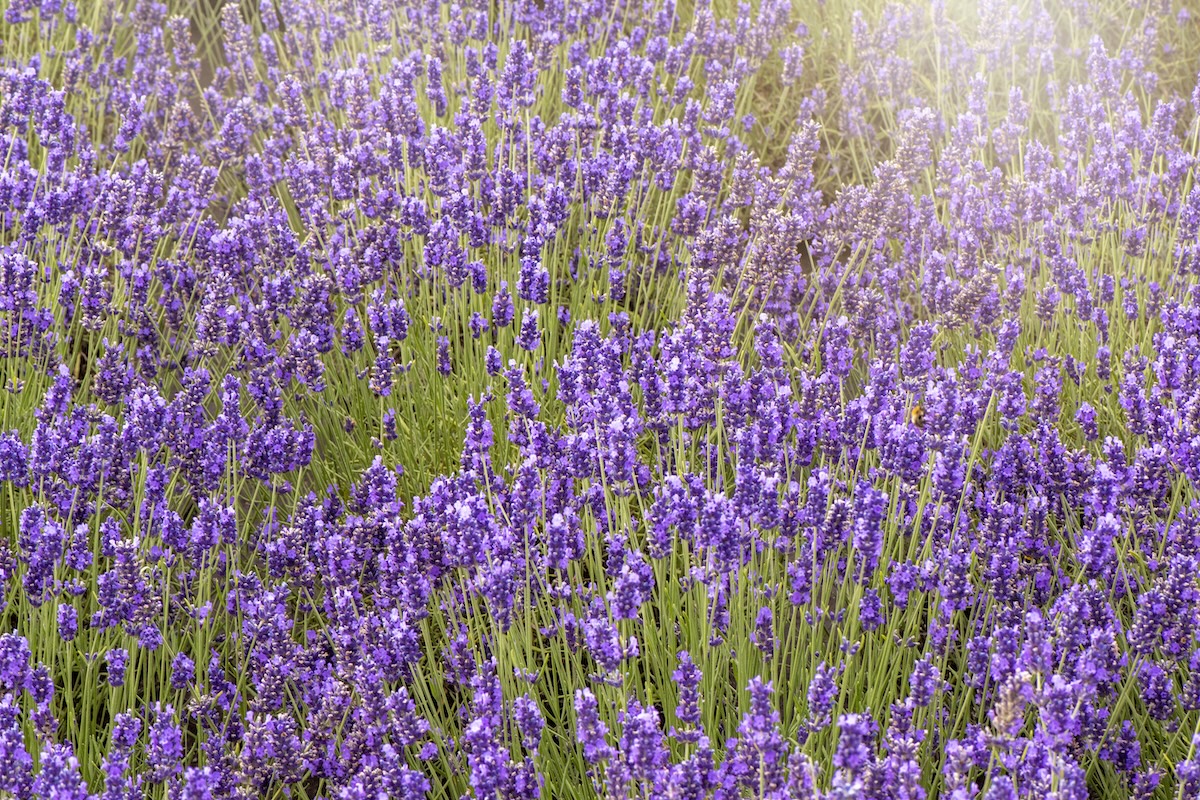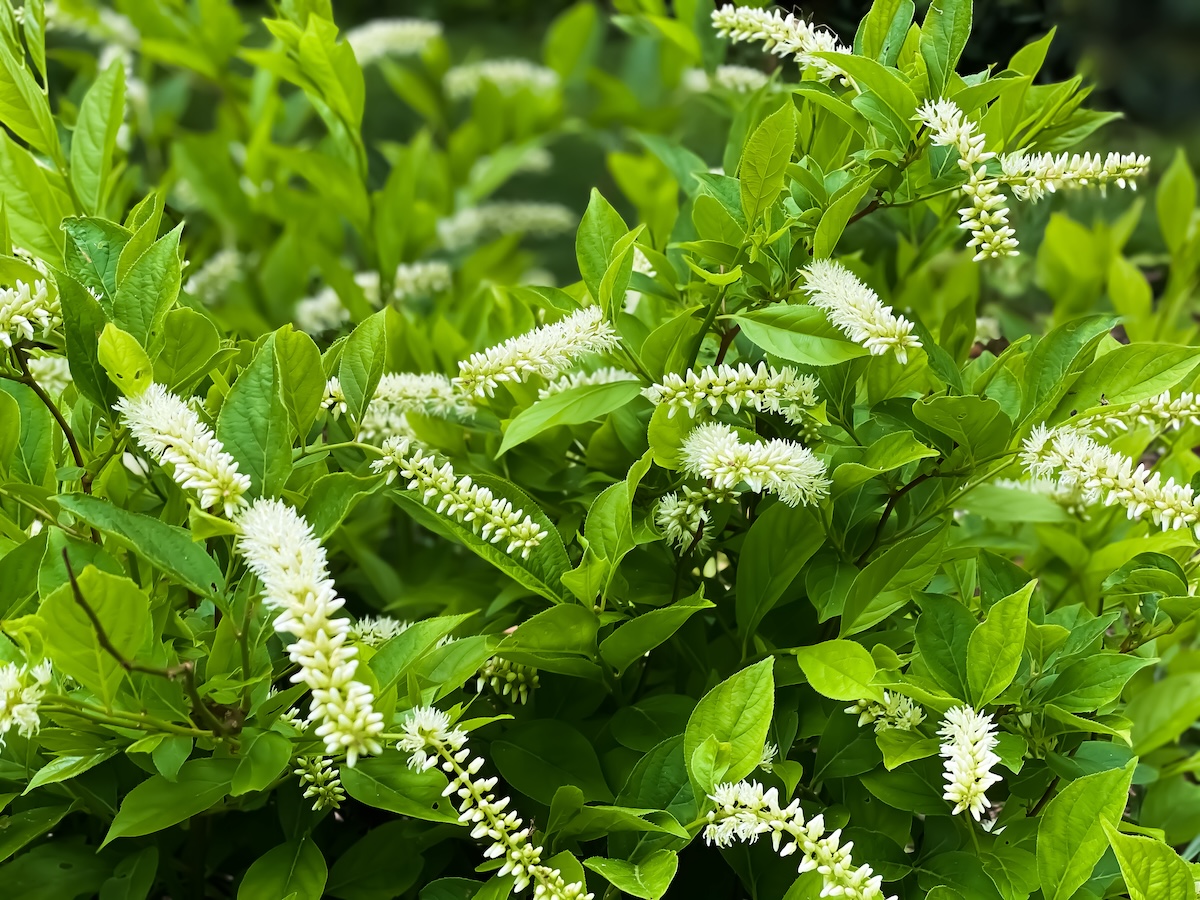

We may earn revenue from the products available on this page and participate in affiliate programs. Learn More ›
Shrubs are often considered foundational plantings that “anchor” your home to the surrounding landscaping. In addition to providing a transition from human-made structures to natural greenery, shrubs can offer privacy or a sound barrier. They can also emphasize architectural features of the house.
But gone are the days of the standard new-construction juniper or boring boxwood plantings. Homeowners today yearn for blooms to beautify their bay window, pretty up their portico, or capture the majesty of their colonnades. Whatever the growing zone, there are flowering shrubs that can become a standout feature for the front of your home.
1. Knock Out Rose (Rosa hybrida)

Disease-resistant, drought-tolerant, fast-growing, and easy to care for, the Knock Out Rose blooms from spring until frost, adding color to your landscape. This self-cleaning rose (meaning no deadheading necessary) comes in a wide range of colors, including white, light pink, deep pink, red, coral, orange, peach, rainbow, and yellow. Once established, these flowering bushes don’t require supplemental watering or fertilizing, but will benefit from a spring pruning to maintain their compact shape.
Best For: Borders, cottage gardens, mass plantings
Hardiness Zones: 5-9
2. Crepe Myrtle (Lagerstroemia)

Often thought of as a Southern tree or shrub, crepe myrtle is one of the showiest flowering shrubs for full sun. Often found in tropical and subtropical climates, they’re known as much for their exfoliated tan or gray bark on multiple trunks as it is for their summertime clouds of ruffled, crepe-like blooms of red, pink, lavender, purple, or white. Crepe myrtles prefer neutral or slightly acidic, well-draining soil, but otherwise need little care.
Best For: Specimen plant, hedge, privacy screen
Hardiness Zones: 6-9
3. Lilac (Syringa vulgaris)

“A fairly hardy shrub,” says Sarah Fletcher, CEO of Flower Delivery based out of the U.K., about the common lilac. It is a fragrant spring bloomer, featuring conical clusters of flowers in lavender, cream, magenta, or white, which make wonderful bouquets and are the source of essential oils used in perfumes. Drought-tolerant, once established, and adaptable to many climates and soils, these blooming bushes are tough and long-lived. “This shrub thrives in full sun and well-drained soil, so it is fit for any altitude, particularly high altitudes, and very cold climates,” says Fletcher.
Best For: Specimen plant, hedge
Hardiness Zones: 3-7
4. Spirea (Spiraea spp.)

There are multiple varieties of spirea, colored in pink, purple, red, or white, all of which are easy to grow as long as they have full sun and well-draining soil. Their flowers are tightly clustered—almost in the shape of a bridal bouquet–and contain five petals and five sepals set against narrow, oval-shaped leaves. Most varieties of this fast-growing deciduous shrub bloom in spring or summer and can grow from 1-1/2 feet to 8 feet tall.
Best For: Foundation, full sun, specimen, hedge, border
Hardiness Zones: 3-8
5. Azalea (Rhododendron subsect. Tsutsusi spp.)

Not all azaleas are evergreen flowering shrubs. However, the Tsutsusi species are. A small- to medium-size shrub with dark, dense foliage, azaleas don’t typically grow higher than 3 to 6 feet tall, and can be pruned for size, shape, or structure. Spring welcomes their blooms in white, pink, purple, red, yellow, or orange. “For tight spaces, consider dwarf Azalea like ‘Stewartstonian’ with orange blooms,” suggests Sal Musto, owner of SalCorp Landscaping & Construction in Massachusetts. It stays under 3 feet tall.
Best For: Feature, foundation, partial shade, acidic soil
Hardiness Zones: 5-9
6. Forsythia (Forsythia intermedia)

If you’re looking for bushes for the front of the house, forsythia creates both a nicely manicured hedge and a striking natural shrub. “Though the primary claim to fame for the forsythia is its very early yellow flowers in spring, providing color to landscapes soon after winter has passed, forsythia will grow in almost any soil,” says Nathan Thorne, horticulturist at Handy Flowers in the U.K. Tolerant of mild drought, poor soils, and partial shade, fast-growing forsythia glows.
Best For: Full sun, partial shade, specimen plant, hedge bushes, privacy
Hardiness Zones: 5-8
7. Hydrangea (Hydrangea paniculata ‘Grandiflora’)

One of the showiest white flowering shrubs, Hydrangea paniculata, is also one of the most popular flowering shrubs for shade. Thriving in partial shade and acidic—or just about any type of soil condition—hydrangeas bloom for an extended period through the summer, with large clusters of white flowers fading to soft pink, says Josh Payne, owner of Classic Gardens in Canada. Despite their height of up to 6 feet or more, they’re good plants for the front of the house.
Best For: Partial shade, background of flower beds, specimens
Hardiness Zones: 3-8
8. Camellia (Camellia japonica)

This evergreen shrub delights with glossy green leaves and lush rose-like flowers in white, coral, pink, yellow, red, and multi-hues. More than 3,000 cultivars and hybrids include winter-blooming varieties, summer-blooming varieties, dwarfs, and bush or standard forms. All prefer full to partial sun and acidic to neutral soil. Camellias are heavy feeders that benefit from a balanced NPK ratio—particularly a slow-release fertilizer application in the spring for acidic plants.
Best For: Hedge, privacy, specimen, foundation plant
Hardiness Zones: 7-9
9. Viburnum (Viburnum spp.)

A fast-growing, low-maintenance, pest-free native, viburnum produces large “balls” of white flowers, akin to hydrangea. They can reach up to 30 feet tall and 15 feet wide, so plan for room to spread. They reward glossy or velvety foliage (depending on the variety), fragrant spring flowers, and red- or purple-hued foliage and berries in autumn—all of which attract pollinators. Deer-resistant, viburnum thrives in slightly acidic soil and partial to full sun.
Best For: Foundation plant, screen, hedge, or border
Hardiness Zones: 2-9
10. Weigela (Weigela florida)

Late spring brings an abundant display of trumpet-shaped pink or red blooms on this large, bushy deciduous plant that can grow up to 10 feet tall and 12 feet wide in full to partial sun. Be careful when pruning, because flowers bloom on the previous year’s branches. Purple-leaved and variegated cultivars keep the color interest going until autumn, and dwarf varieties can make more manageable shrubs for the front of the house.
Best For: Full sun, partial shade, specimen, privacy
Hardiness Zones: 4-8
11. English Lavender (Lavandula angustifolia)

If you’re looking for small flowering shrubs—particularly those with a delicious scent‚—try lavender, which produces aromatic purple flowers in the summer, says Musto. While prized for its fragrance, lavender’s smell deters unwanted pests, such as mosquitoes, mice, and moths, while simultaneously attracting bees and butterflies. It prefers full sun and sandy, alkaline soil. English lavender doesn’t require fertilizer or a lot of water, but prune for shape and more blooms.
Best For: Full sun, sandy or rocky soil, borders
Hardiness Zones: 5-9
12. Virginia Sweetspire (Itea virginica)

The versatile Virginia sweetspire thrives in full sun to partial shade, and can handle moist to wet soil. “If you have heavy clay or soggy soil, consider Virginia sweetspire,” Musto recommends. “It tolerates wet feet [and] provides fall color and fragrant white flowers.” Its long, arching, white flowers appear in spring, followed by “brilliant red fall color,” Thorne indicates. Prune to control spread, but be aware that it blooms on old wood.
Best For: Woodland borders, erosion control, moist to wet soil, fall color, spring blooms
Hardiness Zones: 5-9
13. Oregon Grape (Mahonia spp.)

One of the showiest, most low-maintenance, and drought-tolerant flowering evergreen shrubs is the Oregan grape. It features holly-like leaves and spikes of flower clusters that bloom in late winter. “This shrub blossoms bright yellow flowers in the winter, which is a great way to add a happy spot of color when the weather is dull and gray,” says Jeremy Yamaguchi, CEO of Lawn Love. “After they flower, dark berries emerge.” They are shade loving shrubs that like moist, acidic soil.
Best For: Shade, acidic soil
Hardiness Zones: 5-9
